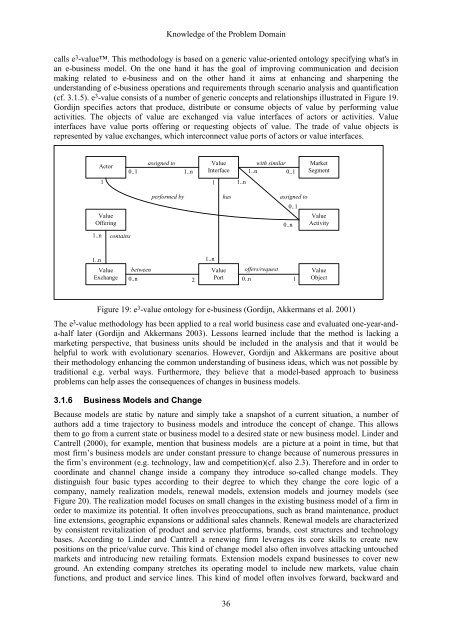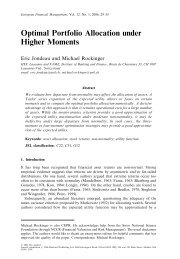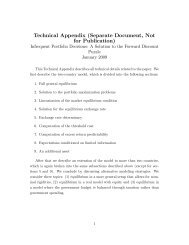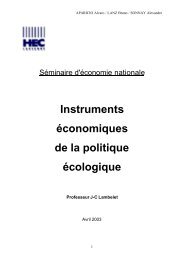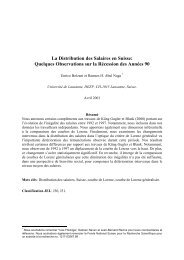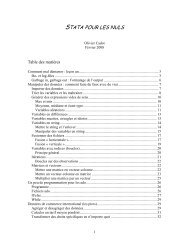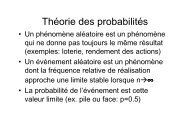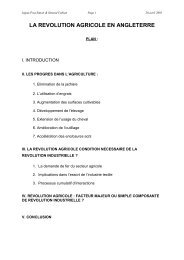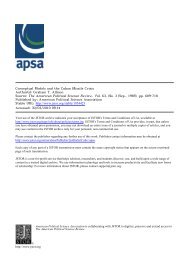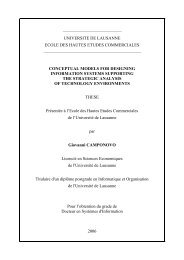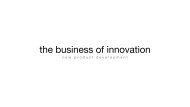The Business Model Ontology - a proposition in a design ... - HEC
The Business Model Ontology - a proposition in a design ... - HEC
The Business Model Ontology - a proposition in a design ... - HEC
You also want an ePaper? Increase the reach of your titles
YUMPU automatically turns print PDFs into web optimized ePapers that Google loves.
Knowledge of the Problem Doma<strong>in</strong><br />
calls e 3 -value. This methodology is based on a generic value-oriented ontology specify<strong>in</strong>g what's <strong>in</strong><br />
an e-bus<strong>in</strong>ess model. On the one hand it has the goal of improv<strong>in</strong>g communication and decision<br />
mak<strong>in</strong>g related to e-bus<strong>in</strong>ess and on the other hand it aims at enhanc<strong>in</strong>g and sharpen<strong>in</strong>g the<br />
understand<strong>in</strong>g of e-bus<strong>in</strong>ess operations and requirements through scenario analysis and quantification<br />
(cf. 3.1.5). e 3 -value consists of a number of generic concepts and relationships illustrated <strong>in</strong> Figure 19.<br />
Gordijn specifies actors that produce, distribute or consume objects of value by perform<strong>in</strong>g value<br />
activities. <strong>The</strong> objects of value are exchanged via value <strong>in</strong>terfaces of actors or activities. Value<br />
<strong>in</strong>terfaces have value ports offer<strong>in</strong>g or request<strong>in</strong>g objects of value. <strong>The</strong> trade of value objects is<br />
represented by value exchanges, which <strong>in</strong>terconnect value ports of actors or value <strong>in</strong>terfaces.<br />
Actor<br />
assigned to<br />
Value with similar<br />
0..1 1..n Interface 1..n 0..1<br />
1 1..n<br />
1<br />
Market<br />
Segment<br />
Value<br />
Offer<strong>in</strong>g<br />
performed by<br />
has<br />
assigned to<br />
0..n<br />
0..1<br />
Value<br />
Activity<br />
1..n<br />
conta<strong>in</strong>s<br />
1..n<br />
Value<br />
Exchange<br />
between<br />
0..n<br />
2<br />
1..n<br />
Value<br />
Port<br />
offers/request<br />
0..n 1<br />
Value<br />
Object<br />
Figure 19: e 3 -value ontology for e-bus<strong>in</strong>ess (Gordijn, Akkermans et al. 2001)<br />
<strong>The</strong> e 3 -value methodology has been applied to a real world bus<strong>in</strong>ess case and evaluated one-year-anda-half<br />
later (Gordijn and Akkermans 2003). Lessons learned <strong>in</strong>clude that the method is lack<strong>in</strong>g a<br />
market<strong>in</strong>g perspective, that bus<strong>in</strong>ess units should be <strong>in</strong>cluded <strong>in</strong> the analysis and that it would be<br />
helpful to work with evolutionary scenarios. However, Gordijn and Akkermans are positive about<br />
their methodology enhanc<strong>in</strong>g the common understand<strong>in</strong>g of bus<strong>in</strong>ess ideas, which was not possible by<br />
traditional e.g. verbal ways. Furthermore, they believe that a model-based approach to bus<strong>in</strong>ess<br />
problems can help asses the consequences of changes <strong>in</strong> bus<strong>in</strong>ess models.<br />
3.1.6 <strong>Bus<strong>in</strong>ess</strong> <strong>Model</strong>s and Change<br />
Because models are static by nature and simply take a snapshot of a current situation, a number of<br />
authors add a time trajectory to bus<strong>in</strong>ess models and <strong>in</strong>troduce the concept of change. This allows<br />
them to go from a current state or bus<strong>in</strong>ess model to a desired state or new bus<strong>in</strong>ess model. L<strong>in</strong>der and<br />
Cantrell (2000), for example, mention that bus<strong>in</strong>ess models are a picture at a po<strong>in</strong>t <strong>in</strong> time, but that<br />
most firm’s bus<strong>in</strong>ess models are under constant pressure to change because of numerous pressures <strong>in</strong><br />
the firm’s environment (e.g. technology, law and competition)(cf. also 2.3). <strong>The</strong>refore and <strong>in</strong> order to<br />
coord<strong>in</strong>ate and channel change <strong>in</strong>side a company they <strong>in</strong>troduce so-called change models. <strong>The</strong>y<br />
dist<strong>in</strong>guish four basic types accord<strong>in</strong>g to their degree to which they change the core logic of a<br />
company, namely realization models, renewal models, extension models and journey models (see<br />
Figure 20). <strong>The</strong> realization model focuses on small changes <strong>in</strong> the exist<strong>in</strong>g bus<strong>in</strong>ess model of a firm <strong>in</strong><br />
order to maximize its potential. It often <strong>in</strong>volves preoccupations, such as brand ma<strong>in</strong>tenance, product<br />
l<strong>in</strong>e extensions, geographic expansions or additional sales channels. Renewal models are characterized<br />
by consistent revitalization of product and service platforms, brands, cost structures and technology<br />
bases. Accord<strong>in</strong>g to L<strong>in</strong>der and Cantrell a renew<strong>in</strong>g firm leverages its core skills to create new<br />
positions on the price/value curve. This k<strong>in</strong>d of change model also often <strong>in</strong>volves attack<strong>in</strong>g untouched<br />
markets and <strong>in</strong>troduc<strong>in</strong>g new retail<strong>in</strong>g formats. Extension models expand bus<strong>in</strong>esses to cover new<br />
ground. An extend<strong>in</strong>g company stretches its operat<strong>in</strong>g model to <strong>in</strong>clude new markets, value cha<strong>in</strong><br />
functions, and product and service l<strong>in</strong>es. This k<strong>in</strong>d of model often <strong>in</strong>volves forward, backward and<br />
36


